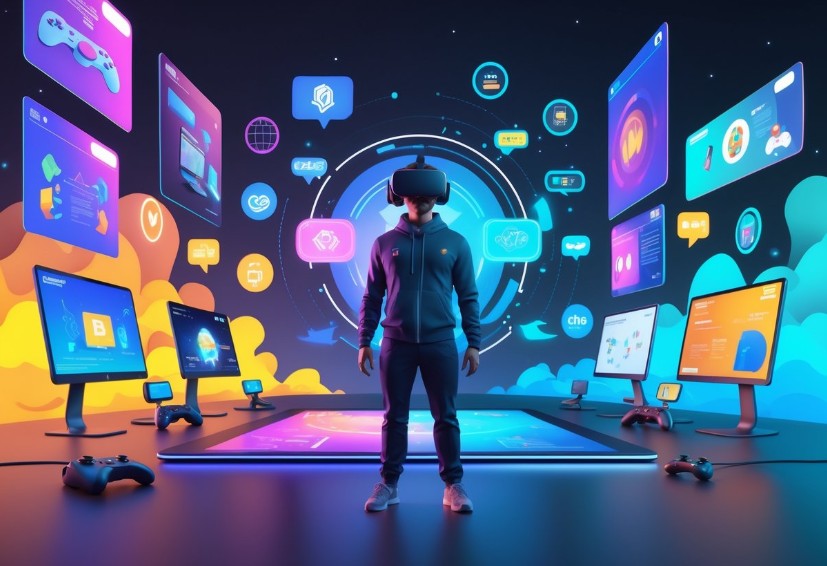Table of Contents
ToggleThe Shift From Gaming to Niche Virtual Reality Platforms
Virtual reality platforms aren’t just for gamers anymore. These days, immersive tech is showing up in healthcare, education, design, and more, places where real-world impact matters just as much as fun.
That’s partly thanks to better hardware and a growing appetite for solutions that go way beyond play. It’s wild how quickly things have shifted, right?
Emergence of Specialized VR Applications
In healthcare, VR systems give surgeons the chance to rehearse tricky procedures in a risk-free setting. Medical students can poke around 3D anatomy models, so much more vivid than a static page.
Therapists now use virtual environments to help patients face phobias or PTSD, offering exposure therapy that feels real but stays safe. It’s a game changer for mental health.
Education’s getting a serious upgrade too. Imagine students walking ancient streets or diving into cell biology, all from a classroom. These immersive experiences stick with you in a way lectures just don’t.
Architecture and engineering teams rely on VR walkthroughs to catch design flaws before concrete’s even poured. Clients can “step inside” their future home, making changes on the fly.
Corporate trainers use VR for everything from customer service practice to emergency response drills. It’s practical, and honestly, a lot less boring than a slideshow.
Key Drivers Behind Platform Diversification
Why are we seeing so many new flavors of virtual reality platforms? For starters, hardware keeps getting better, lighter headsets, sharper images, and smoother motion tracking.
That means people can actually wear these things for a while without feeling seasick. It’s a big deal for anyone using VR at work or in class.
Content’s another piece. Industries now have access to custom VR tools, like medical simulators or architectural visualizers, built just for them. That makes the tech actually useful, not just flashy.
And let’s not ignore price. Early VR rigs cost a fortune, but newer models are way more budget-friendly. Cloud-based platforms make it even easier for businesses to jump in without a huge upfront spend.
Market Trends Shaping Niche VR Growth
The virtual reality market’s shifting fast. Companies are pouring resources into platforms built for specific fields, healthcare, education, and enterprise training are seeing some of the fastest growth out there.
It’s not just about saving money on training or boosting learning, either. Social VR environments are starting to replace video calls, letting people “meet” in shared digital spaces.
There’s even a push for sustainability. Some platforms simulate climate change or ecological systems for research and education, showing VR can serve bigger causes too.
Technological Foundations Powering Modern VR Platforms

Modern virtual reality platforms lean on a mix of hardware, sensors, and design tricks to make everything feel real. Headsets are lighter, motion tracking is sharper, and haptic feedback adds that “you’re really there” vibe.
Want the nitty-gritty? Here’s how these systems are getting so good at what they do.
Advancements in VR Hardware and Headsets
Headsets like the Oculus Quest, HTC Vive, and Lenovo Mirage Solo have seriously upped the game. Higher-res screens, bigger fields of view, and less neck strain, what’s not to like?
Standalone headsets are a big leap. No more crazy cables or need for a monster PC. Just put it on and go. That’s making VR way more accessible for everyone.
Manufacturers are also fighting motion sickness with faster refresh rates and better optics. Even cheaper headsets now offer smooth visuals that used to be reserved for the high-end crowd.
Going wireless means you can move naturally, which is huge for training and education. Nothing kills immersion like tripping over a cord.
Role of Motion Sensors and Haptic Feedback in Virtual Reality Platforms
Motion sensors track your every move, head, hands, even your whole body. Some setups use external base stations, while newer ones have cameras built right in. It’s less hassle, more precision.
Controllers are getting smarter, too. Advanced sensors pick up on finger placement, letting you grab or point naturally instead of mashing buttons.
Then there’s haptic feedback. Vibrations and pressure responses can mimic drawing a bow or touching a rough surface. It’s subtle, but it really sells the illusion.
Developers are blending motion tracking and haptics for training that feels real, especially in fields like surgery where muscle memory is everything.
Importance of Immersion and Presence in VR
Immersion and presence, those are the magic words. Immersion’s about the tech: sharp graphics, spatial sound, and quick response times.
Presence is trickier, it’s when your brain buys into the illusion and you forget you’re wearing a headset. That’s when VR gets really powerful.
Any lag or visual hiccup can snap you out of it. So, better processors and optics aren’t just nice to have, they’re essential for keeping you “in” the virtual space.
For therapy and remote teamwork, presence isn’t just cool, it’s crucial. It’s what lets people connect and learn in ways video calls just can’t match.
Beyond Entertainment: Expanding VR Use Cases
Virtual reality platforms now help people practice, learn, and experience things they’d never get to otherwise. It’s not just about fun, there’s real-world value here.
VR in Education and Training
Teachers are using VR to drop students right into the action. Picture a history class walking through ancient Rome, or a biology lesson inside the human body.
It’s not just for kids, either. Pilots, engineers, and mechanics get hands-on practice in virtual settings before touching real equipment. Mistakes don’t cost a thing, but the lessons stick.
For companies, VR training means less travel and more consistency. You can roll out the same module to every location, no matter where people are.
- Higher engagement
- Safe practice
- Consistent learning everywhere
Healthcare and Therapeutic Applications of Virtual Reality Platforms
Hospitals and clinics use VR to prep medical staff without risking patient safety. Surgeons can rehearse, nurses can run emergency drills, it’s hands-on without the pressure.
Therapists use VR for exposure therapy, letting patients confront fears or trauma in a controlled way. It’s a lifeline for folks dealing with anxiety or PTSD.
Even pain management’s getting a boost. Immersive experiences distract patients during tough procedures, cutting down on meds and stress.
- Surgical practice
- Phobia and PTSD treatment
- Pain distraction
Virtual Travel and Walkthroughs
With VR, you can tour the Great Wall or Machu Picchu without leaving your couch. It’s a window to the world for students and armchair travelers alike.
Architects and realtors use virtual walkthroughs to show off spaces before they’re built or sold. Clients can explore, suggest tweaks, and get a feel for the place early on.
For anyone who can’t travel, maybe for health or budget reasons, virtual exploration is a pretty great alternative. It opens the door to experiences that might otherwise be out of reach.
Social VR and Virtual Communities
Virtual reality platforms are morphing into shared spaces where people hang out, collaborate, and build worlds together. It’s not just about playing games anymore, it’s about connection.
Rise of Social VR Platforms
Platforms like VRChat, AltspaceVR, and Horizon Worlds are now hubs for digital communities. They’re less about gameplay, more about meeting up, chatting, or joining events.
You can catch a concert, join a book club, or just wander through wild user-created spaces with friends. It’s a new kind of social life, and honestly, it’s catching on fast.
Some platforms focus on features like spatial audio or custom avatars, while others prioritize big, open communities. It’s interesting to see how each one carves out its own vibe.
Building Presence in Virtual Environments
Presence is what sets social VR apart. Voice, gestures, even eye movements are tracked, so avatars feel alive and conversations flow naturally.
Honestly, it feels more like being with someone than any video call I’ve tried. You’re not just staring at a screen, you’re sharing a space.
This kind of connection lets people collaborate, celebrate, or just unwind together, no matter where they are in the world.
Content Creation and User-Generated Worlds
User-generated content is the engine behind these communities. VRChat, for example, lets anyone design avatars or build custom rooms, no coding degree required.
People get creative, from shared meeting spaces to wild fantasy worlds. Some use simple in-app tools, others go all-in with pro 3D modeling software.
As more folks pitch in, these digital spaces keep growing and evolving, shaped by the people who call them home.
Leading VR Platforms and Ecosystem Players
The biggest names in virtual reality platforms set the tone for the whole industry. Their choices in hardware, software, and how they connect people ripple out to everyone else.
Oculus and Meta’s Ecosystem
Oculus, now under Meta’s wing, is one of the most recognized brands in VR. The Oculus Quest series really shook things up by ditching the need for a gaming PC or console.
This move made VR way more approachable for everyday folks. You can use native apps from the Meta Store or hook up to a PC for more demanding stuff. Flexibility matters.
Meta’s also pushing hard into social VR with Horizon Worlds, tying hardware to big digital spaces. It’s all part of their metaverse vision, and honestly, it’ll be interesting to see where it goes next.
For a deeper dive into VR’s evolution, check out our industry trends analysis or learn about top headsets and accessories. You can also explore how social VR chatrooms are changing the game.
Sony PlayStation VR and Console Integration
Sony’s PlayStation VR (PSVR) stands out among Virtual Reality Platforms by tapping into the PlayStation console’s massive install base. That gives it a head start, right?
The original PSVR launched for PlayStation 4. Then came PSVR2, built for the PlayStation 5, boasting sharper displays, inside-out tracking, and much better controllers.
Unlike standalone VR headsets, PlayStation’s VR hardware needs the console to run. That’s a tradeoff: you get tight integration with PlayStation’s games and ecosystem, but you’re tethered to the living room.
Developers can craft VR games that really push the console’s hardware, making use of a deep game library and PlayStation’s processing muscle.
Sony’s focus is squarely on immersive gaming, don’t expect productivity apps to steal the show here. Exclusive releases and close developer ties keep PSVR at the top for those who crave console-quality virtual experiences without jumping into PC upgrades.
HTC Vive and PC-Based Virtual Reality Platforms
The HTC Vive lineup has long been the go-to for high-end PC-based VR. If you’re after advanced tracking, graphics, or simulation, you’ll need a pretty beefy computer, but the payoff is real precision.
HTC’s range includes the Vive Pro series for business and the Vive Cosmos for regular folks. There are also Vive Trackers for full-body tracking, which can get a bit wild when you see them in action.
What’s interesting about this VR ecosystem is its openness. With SteamVR support, users get access to a massive library, not just HTC’s own selection. That kind of flexibility, paired with robust hardware, makes Vive a solid pick for those who value performance and customization above all.
Notable VR Content and Experiences
Virtual Reality Platforms are finally moving beyond tech demos. Now, you’ll find polished content that draws in gamers and non-gamers alike. From blockbuster VR games to wild new forms of interactive media and VR entertainment, the landscape just keeps growing.
Breakthrough Games on Virtual Reality Platforms
Certain VR games have become the gold standard for immersive play. Beat Saber is a great example, it mixes rhythm action and motion controls in a way that’s surprisingly addictive and physical.
Its popularity shows that these immersive platforms can create brand-new genres, not just port over old ideas.
Then there’s Half-Life: Alyx. This one raised the bar for story-driven VR. With its detailed worlds, tactile interactions, and gripping narrative, it proved that full-length, AAA-quality titles really do have a home in virtual reality.
Superhot VR flips the script by slowing time as you move. That mechanic feels like it was made for VR, try it, and you’ll see why it’s impossible to pull off in traditional games.
Games like these don’t just mimic what came before. They use physicality, spatial awareness, and immersion to do things you just can’t get on a flat screen.
Innovative VR Content Formats
Virtual Reality Platforms have come a long way, and they’re definitely not just about gaming anymore. Immersive experiences now stretch into interactive films, live concerts, and social hubs where folks can create and share their own virtual spaces.
These fresh formats are pulling in audiences who care about culture, education, or just hanging out, not only gamers. It’s kind of wild how much the audience has grown.
Educational content in these virtual environments lets students wander ancient ruins or run science experiments in digital labs, way safer, and honestly, sometimes more engaging than the real thing.
Training simulations on these platforms prep workers in high-risk fields, all without stepping into actual danger. The stats are compelling: according to PwC, VR training can be up to four times faster than classroom learning, and learners are 275% more confident to apply skills after training.
Social VR spaces like VRChat or Rec Room are proof that content creation can really be a team sport. People design their own avatars, build environments, and even throw events, making these platforms feel more like a digital neighborhood than just another app.
It’s fascinating to see how these Virtual Reality Platforms are shifting from passive entertainment to active, shared creativity.






